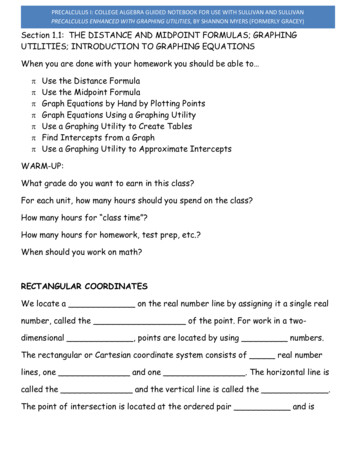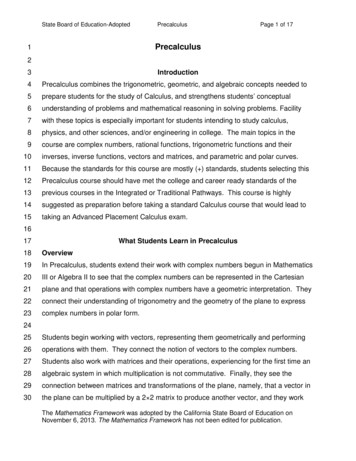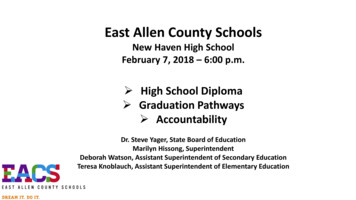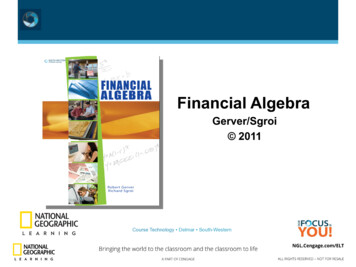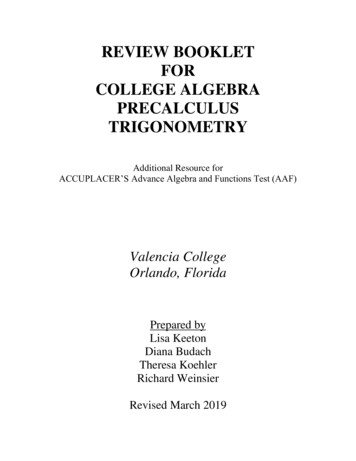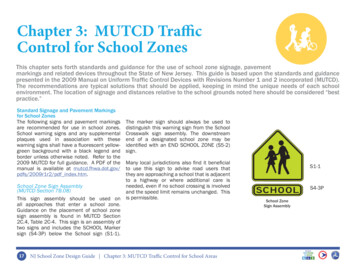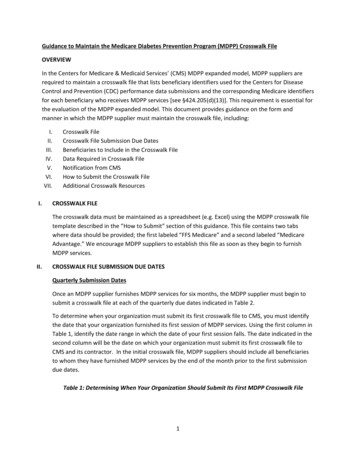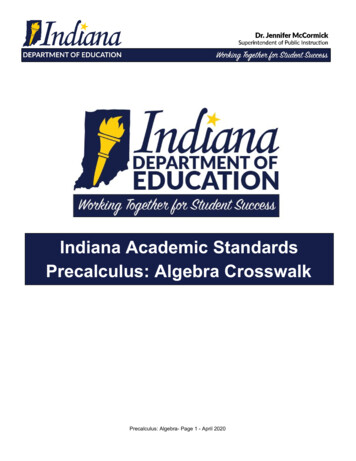
Transcription
Indiana Academic StandardsPrecalculus: Algebra CrosswalkPrecalculus: Algebra- Page 1 - April 2020
2014 Standard Language2020 Standard LanguageSuggested ChangesPrecalculus: AlgebraPolar Coordinates and Complex Numbers - REMOVED CLUSTERPC.PCN.1: Calculate the distancebetween numbers in the complexplane as the modulus of thedifference, and the midpoint of asegment as the average of thenumbers at its endpoints.Removed standardPC.PCN.2: Understand and usecomplex numbers, including realand imaginary numbers, on thecomplex plane in rectangular andpolar form, and explain why therectangular and polar forms of agiven complex number representthe same number.Removed standardPC.PCN.3: Understand and useaddition, subtraction,multiplication, and conjugation ofcomplex numbers, including realand imaginary numbers, on thecomplex plane in rectangular andpolar form.Removed standardPC.PCN.4: State, prove, and useDeMoivre’s Theorem.Removed standardMoved to 2020 PC.QPR.3No language changeMoved to 2020 TR.PC.1No language changeMoved to 2020 PC.QPR.2Language changeRemoved “ including realand imaginary numbers,on the complex plane inrectangular and polarform”.Moved to 2020 TR.PC.2Precalculus: Algebra- Page 2 - April 2020
No language changeFunctionsPC.F.1: For a function thatmodels a relationship betweentwo quantities, interpret keyfeatures of graphs and tables interms of the quantities, andsketch graphs showing keyfeatures given a verbaldescription of the relationship.Key features include: intercepts;intervals where the function isincreasing, decreasing, positive,or negative; relative maximumsand minimums; symmetries; endbehavior; and periodicity.PC.F.1: For a function thatmodels a relationship betweentwo quantities, interpret keyfeatures of graphs and tables interms of the quantities, andsketch graphs showing keyfeatures given a verbaldescription of the relationship.Key features include: intercepts;intervals where the function isincreasing, decreasing, positive,or negative; relative maximumsand minimums; symmetries; endbehavior; and periodicity.No changePC.F.2: Find linear models byusing median fit and leastsquares regression methods.Decide which among severallinear models gives a better fit.Interpret the slope and interceptin terms of the original context.PC.F.2: Find linear models byusing median fit and leastsquares regression methods,making use of technology.Decide which among severallinear models gives a better fit.Interpret the slope and interceptin terms of the original context.Language changePC.F.3: Recognize thatsequences are functions,sometimes defined recursively,whose domain is a subset of theintegers.Added “making use oftechnology”.Removed StandardMoved to 2020 PC.SS.1No language changePC.F.3: Compose functions andfind the domain of compositefunctions.Precalculus: Algebra- Page 3 - April 2020New Standard
PC.F.4: Determine if a graph ortable has an inverse, and justify ifthe inverse is a function, relation,or neither. Identify the values ofan inverse function/relation froma graph or a table, given that thefunction has an inverse. Derivethe inverse equation from thevalues of the inverse.PC.F.4: Determine if a graph orNo changetable has an inverse, and justify ifthe inverse is a function, relation,or neither. Identify the values ofan inverse function/relation froma graph or a table, given that thefunction has an inverse. Derivethe inverse equation from thevalues of the inverse.PC.F.5: Produce an invertiblePC.F.5: Produce an invertiblefunction from a non-invertiblefunction from a non-invertiblefunction by restricting the domain. function by restricting thedomain.No changePC.F.6: Describe the effect onthe graph of replacing f(x) by f(x) k, k f(x),f(kx), and f(x k) forspecific values of k (both positiveand negative). Find the value ofk given the graph f(x) and thegraph of f(x) k, k f(x), f(kx), orf(x k). Experiment with casesand illustrate an explanation ofthe effects on the graph usingtechnology. Recognize even andodd functions from their graphsand algebraic expressions.Language changePC.F.6: Recognize even and oddfunctions from their graphs andalgebraic expressions.PC.F.7: Decide if a function iscontinuous at a point. Find thetypes of discontinuities of afunction and relate them tofinding limits of a function. UseRemoved “Describe theeffect on the graph ofreplacing f(x) by f(x) k, kf(x),f(kx), and f(x k) forspecific values of k (bothpositive and negative).Find the value of k giventhe graph f(x) and thegraph of f(x) k, k f(x),f(kx), or f(x k).Experiment with casesand illustrate anexplanation of the effectson the graph usingtechnology.”Removed standardPrecalculus: Algebra- Page 4 - April 2020
the concept of limits to describediscontinuity and end-behavior ofthe function.PC.F.8: Define arithmetic andgeometric sequences recursively.Use a variety of recursionequations to describe a function.Model and solve word problemsinvolving applications ofsequences and series, interpretthe solutions and determinewhether the solutions arereasonable.Removed standardPC.F.9: Use iteration andrecursion as tools to represent,analyze, and solve problemsinvolving sequential change.Removed standardPC.F.10: Describe the concept ofthe limit of a sequence and a limitof a function. Decide whethersimple sequences converge ordiverge. Recognize an infiniteseries as the limit of a sequenceof partial sums.Removed standardQuadratic, Polynomial, and Rational Equations and FunctionsPC.QPR.1: Use the method ofcompleting the square totransform any quadratic equationinto an equation of the form (x –p) 2 q that has the samesolutions. Derive the quadraticformula from this form.PC.QPR.1: Use the method ofcompleting the square totransform any quadratic equationinto an equation of the form (x –p)2 q that has the samesolutions. Derive the quadraticformula from this form.Precalculus: Algebra- Page 5 - April 2020No change
PC.QPR.2: Understand and useaddition, subtraction,multiplication, and conjugation ofcomplex numbers.New standardMoved from 2014PC.PCN.3Language changeRemoved “ including realand imaginary numbers,on the complex plane inrectangular and polarform”.PC.QPR.2: Graph rationalfunctions with and withouttechnology. Identify and describefeatures such as intercepts,domain and range, andasymptotic and end behavior.PC.QPR.6: Graph rationalfunctions with and withouttechnology. Identify anddescribe features such asintercepts, domain and range,and asymptotic and endbehavior.Indicator changePC.QPR.3 Calculate the distancebetween numbers in the complexplane as the modulus of thedifference, and the midpoint of asegment as the average of thenumbers at its endpoints.New standardPC.QPR.3: Know and apply thePC.QPR.4: Know and apply theRemainder Theorem: For aRemainder Theorem and thepolynomial p(x) and a number a,Factor Theorem.the remainder on division by x – ais p(a), so p(a) 0 if and only if (x– a) is a factor of p(x).Precalculus: Algebra- Page 6 - April 2020No language changeMoved from 2014PC.PCN.1No language changeIndicator changeLanguage changeAdded “Factor Theorem”Removed “For apolynomial p(x) and anumber a, the remainderon division by x – a is p(a),so p(a) 0 if and only if (x
– a) is a factor of p(x)”PC.QPR.4: Understand theFundamental Theorem ofAlgebra. Find a polynomialfunction of lowest degree withreal coefficients when given itsroots.PC.QPR.5: Understand theFundamental Theorem ofAlgebra. Find a polynomialfunction of lowest degree withreal coefficients when given itsroots.Indicator changeNo language changeExponential and Logarithmic Functions and EquationsPC.EL.1: Use the definition oflogarithms to convert logarithmsfrom one base to another andprove simple laws of logarithms.PC.EL.1: Use the definition oflogarithms to convert logarithmsfrom one base to another andprove simple laws of logarithms.PC.EL.2: Use the laws oflogarithms to simplify logarithmicexpressions and find theirapproximate values.PC.EL.2: Use the laws ofLanguage changelogarithms to simplify logarithmicAdded “and solveexpressions, approximate thelogarithmic equations”value of a logarithmic expression,and solve logarithmic equations.PC.EL.3: Graph and solvereal-world and othermathematical problems that canbe modeled using exponentialand logarithmic equations andinequalities; interpret the solutionand determine whether it isreasonable.PC.EL.3: Graph and solvereal-world and othermathematical problems that canbe modeled using exponentialand logarithmic functions;interpret the solution anddetermine whether it isreasonable. Identify and describefeatures such as intercepts,domain, range, asymptotes, andend behaviorLanguage changePC.EL.4: Use technology to find a PC.EL.4: Use technology to findquadratic, exponential,a quadratic, exponential,Language changePrecalculus: Algebra- Page 7 - April 2020No changeChanged “equations andinequalities; interpret thesolution and determinewhether it is reasonable”to “ functions; interpret thesolution and determinewhether it is reasonable.Identify and describefeatures such asintercepts, domain, range,asymptotes, and endbehavior”
logarithmic, or power function thatmodels a relationship for abivariate data set to makepredictions; compute (usingtechnology) and interpret thecorrelation coefficient.logarithmic, or power functionthat models a relationship for abivariate data set to makepredictions.Removed “compute (usingtechnology) and interpretthe correlation coefficient”.Sequences and Series - NEW CLUSTERPC.SS.1: Recognize thatsequences are functions,sometimes defined recursively,whose domain is a subset of theintegers.New standardPC.SS.2: Write arithmetic andgeometric sequences bothrecursively and with an explicitformula; use them to modelsituations and translate betweenthe two forms.New standardPC.SS.3: Find partial sums ofarithmetic and geometric seriesand represent them using sigmanotation.New standardMoved from 2014 PC.F.3No language changeMoved from 2014 AII.EL.1No language changeMoved from 2014AII.CNE.6No language changePC.SS.4: Model and solvereal-world problems involvingapplications of sequences andseries, interpret the solutions anddetermine whether the solutionsare reasonable.New standardAdapted from previousPC.F.8Conics - NEW CLUSTER - ADAPTED AND MOVED FROM TRIGONOMETRYPC.CO.1: Construct thePrecalculus: Algebra- Page 8 - April 2020New standard
equation of a parabola given afocus and directrix.Moved from 2014TR.CO.2Language changeChanged “Derive” to“Construct”PC.CO.2: Construct theequation of a circle of givencenter and radius. Complete thesquare to find the center andradius of a circle given by anequation.New standardMoved from 2014TR.CO.3Language changeChanged “Derive” to“Construct”Removed “usingPythagorean Theorem”PC.CO.3: Construct theequations of ellipses andhyperbolas given at least two ofthe following: foci, vertices,length of an axis, or point on thecurve.New standardMoved from 2014TR.CO.4Language changeAdded “ given at least 2 ofthe following: foci,vertices, length of an axis,or point on the curve”.Removed “using the factthat the sum or differenceof distances from the fociis constant”.Changed “Derive” to“Construct”Precalculus: Algebra- Page 9 - April 2020
PC.CO.4: Graph conic sections.Identify and describe featureslike center, vertex or vertices,focus or foci, directrix, axis ofsymmetry, major axis, minor axis,and eccentricity.New standardMoved from 2014TR.CO.5No language changeParametric Equations - REMOVED CLUSTERPC.PE.1: Convert between a pairof parametric equations and anequation in x and y. Model andsolve problems using parametricequations.Removed standardPC.PE.2: Analyze planar curves,including those given inparametric form.Removed standardPrecalculus: Algebra- Page 10 - April 2020
Precalculus: Algebra Polar Coordinates and Complex Numbers - REMOVED CLUSTER PC.PCN.1: Calculate the distance between numbers in the complex plane as the modulus of the difference, and the midpoint of a segment as the average of the numbers at its endpoints. Removed standard Moved to 2020 PC.QPR.3 No language change PC.PCN.2: Understand and use

